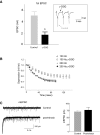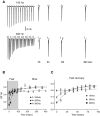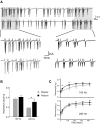Short-term synaptic depression and recovery at the mature mammalian endbulb of Held synapse in mice
- PMID: 18632895
- PMCID: PMC2544465
- DOI: 10.1152/jn.90715.2008
Short-term synaptic depression and recovery at the mature mammalian endbulb of Held synapse in mice
Abstract
The endbulb of Held synapses between the auditory nerve fibers (ANF) and cochlear nucleus bushy neurons convey fine temporal information embedded in the incoming acoustic signal. The dynamics of synaptic depression and recovery is a key in regulating synaptic transmission at the endbulb synapse. We studied short-term synaptic depression and recovery in mature (P22-38) CBA mice with stimulation rates that were comparable to sound-driven activities recorded in vivo. Synaptic depression in mature mice is less severe ( approximately 40% at 100 Hz) than reported for immature animals and the depression is predominately due to depletion of releasable vesicles. Recovery from depression depends on the rate of activity and accumulation of intracellular Ca2+ at the presynaptic terminal. With a regular stimulus train at 100 Hz in 2 mM external [Ca2+], the recovery from depletion was slow (tauslow, approximately 2 s). In contrast, a fast (taufast, approximately 25 ms), Ca2+-dependent recovery followed by a slower recovery (tauslow, approximately 2 s) was seen when stimulus rates or external [Ca2+] increased. In normal [Ca2+], recovery from a 100-Hz Poisson-like train is rapid, suggesting that Poisson-like trains produce a higher internal [Ca2+] than regular trains. Moreover, the fast recovery was slowed by approximately twofold in the presence of calmidazolium, a Ca2+/calmodulin inhibitor. Our results suggest that endbulb synapses from high spontaneous firing rate auditory nerve fibers normally operate in a depressed state. The accelerated synaptic recovery during high rates of activity is likely to ensure that reliable synaptic transmission can be achieved at the endbulb synapse.
Figures






References
-
- Bellingham MC, Walmsley B. A novel presynaptic inhibitory mechanism underlies paired pulse depression at a fast central synapse. Neuron 23: 159–170, 1999. - PubMed
-
- Bollmann JH, Sakmann B. Control of synaptic strength and timing by the release-site Ca2+ signal. Nat Neurosci 8: 426–434, 2005. - PubMed
-
- Bollmann JH, Sakmann B, Borst JG. Calcium sensitivity of glutamate release in a calyx-type terminal. Science 289: 953–957, 2000. - PubMed
Publication types
MeSH terms
Substances
Grants and funding
LinkOut - more resources
Full Text Sources
Miscellaneous

